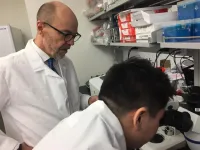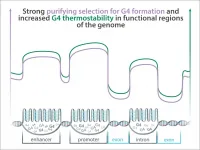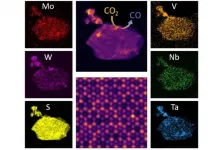(Press-News.org) This lobster tale begins a few years ago when the proprietor of a northeastern seafood restaurant publicly asserted that exposing lobsters to a little cannabis prior to cooking produced notable changes in their behavior and a less dramatic scene in the kitchen for all concerned, which was the Maine thing.
In a paper published online June 29, 2021 in the journal Pharmacology Biochemistry and Behavior, a team led by researchers at University of California San Diego School of Medicine, report on efforts to answer that burning, boiling and baked question. They obtained live lobsters (Homarus americanus) from a supermarket and exposed the crustaceans to up to 60 minutes of vaporized Δ9-tetrahydrocannabinol (THC) -- the principle psychoactive component of cannabis -- then measured THC levels in the animals' tissues and looked for behavioral changes, including thermal nociception, the perception of heat or cold.
The issue of whether lobsters feel pain when dropped into a cooking pot of boiling water is long-simmering. Though live cooking of lobsters has been banned in Switzerland (2018) and New Zealand (1999), based on that presumption, most scientists say empirical evidence that crustaceans are sensitive or can even detect temperature changes is far from clear.
A study at Queen's University in Belfast, published in 2013, exposed the claws of shore crabs (Carcinus maenas) to electrical shocks. The crabs learned to avoid them, a behavior the study authors said was "consistent with key criteria for pain experience."
A 2015 study at the University of Texas-Pan American found that Louisiana red swamp crayfish (Procambarus clarkii) displayed nociceptive behavior (responses to extreme temperatures) when briefly touched by a soldering iron at 129 degrees Fahrenheit, but not to low temperature or chemical stimuli, such as capsaicin, the active component in chili peppers.
The University of Texas authors concluded the crayfish possessed some nociceptive behaviors, but cautioned against over-interpreting the results. "We wish to be clear that we are not claiming crustaceans generally, or even crayfish specifically, feel pain," they wrote. "We are claiming that crayfish detect and respond to noxious high temperature stimuli in ways that they do not to other potentially noxious stimuli."
Michael A. Taffe, PhD, professor in the Department of Psychiatry at UC San Diego School of Medicine and senior author of the newest study, and colleagues had already documented in 2016 that inhaled THC produced anti-nociceptive effects in rats, blocking pain detection, and reduced the rodents' body temperature and physical activity. Given the restauranteur's claims, they were curious whether THC acted similarly upon lobsters, which are a well-established animal model for neurological research.
"Lobster models have contributed much to our understanding of neurotransmission and neuronal circuits," said Taffe, "most notably in the work of (Brandeis University neuroscientist) Eve Marder, who began her work when she was a graduate student at UC San Diego."
Though primarily an aquatic species, lobsters are able to survive for hours to days out of water if their gills (located inside their carapace or shell) remain moist enough to function. The UC San Diego researchers set up a sealed tank in which residing lobsters would be exposed to carefully calibrated levels of vaporized THC for 30 or 60 minutes.
The scientists subsequently measured levels of THC in tissue samples from some of the lobsters, including gills, brain, heart, liver, tail and claw. Claw samples where boiled for 10 minutes to determine if THC levels were reduced or eliminated by cooking.
The behaviors of other lobsters were monitored before and after THC exposure for changes, such as more or less time spent moving around, distance traveled and speed. Lobsters also had their claws and tails dipped in water ranging in temperature from ambient to 118 degrees Fahrenheit for up to 15 seconds. (Human showers typically range in water temperature from 105 to 112 degrees F.)
Taffe said the results were mixed. The primary finding was that Maine lobsters are capable of absorbing vaporized THC into their bodies by gill respiration, based on tissue samples. They also exhibited less locomotor activity, similarly to THC-exposed rodents. Responses to different water temperatures varied: the warmer the water, the more rapidly the lobsters moved their claws, tail or antennae away from the liquid, but THC exposure had very minimal effect on detection of a hot water stimulus in the study.
"This is the first direct evidence of thermal nociception in lobsters," said Taffe.
But does that constitute feeling pain? Taffe and colleagues cannot say with certainty: Detection of a stimulus is not synonymous with pain. Lobsters responded to THC exposure much less dramatically than rodents in both behavior and response to adverse stimuli.
"The assertions of the restaurateur that lobsters can be affected by vaping cannabinoids appears confirmed by their subsequent behavior," said Taffe, "but the impact of THC on thermal nociception was minimal. You would need to do more experimentation to fully investigate behavioral outcomes, including anxiety-like measures, which we did not address."
INFORMATION:
Co-authors include: Arnold Gutierrez, Kevin M. Creehan and Jacques D. Nguyen, UC San Diego and TSRI; Mitchell Turner, UC San Diego and Colorado College; Rachel Tran, UC San Diego and University of Washington; and Tony M. Kerr, TSRI.
June 29, 2021 - Nutley, NJ - Scientists from the Hackensack Meridian Center for Discovery and Innovation, working with collaborators from across the globe, uncovered the mechanism of action of a novel anti-tuberculosis drug that they have helped develop.
The new findings show how the enzyme inhibitor triaza-coumarin, or TA-C, is metabolized by the TB germs, which makes it effective in inhibiting the disease from within, like in a "Trojan horse" attack, according to the new paper in the journal Proceedings of the National Academy of Sciences.
"This is a promising new direction of research," said Thomas Dick, member of the CDI faculty. "We are hoping this work can make a difference in the ongoing fight against TB."
"The scientists at the CDI who specialize in ...
For many years, researchers have been focused on developing technologies that can help us fight the imminent climate change crisis. They have one goal in common: finding sustainable energy sources that can replace the environmentally toxic fossil fuels. "Photocatalysts" that drive an artificial process that replicates photosynthesis (in which solar energy is converted to useful materials) are promising in this regard, given that we are able to develop the technology needed for them. Crystalline materials, such as strontium titanate (SrTiO3), which can serve as "photocatalysts" in solar devices, can lead us in the direction.
SrTiO3 is attractive owing to various other reasons ...
Basic needs of disaster- and conflict-impacted refugees are often met by humanitarian relief goods and services, and until now little was known about how refugees create economic livelihood beyond immediate relief.
A new exploratory case study from Portland State University Associate Professor of Management Theodore Khoury reveals how Syrian refugees in the Za'atari camp reached beyond basic disaster relief support and leveraged social capital to create informal economic systems that helped improve their quality of life. The study, "Towards a theory of informal supply networks: An?exploratory case study of the Za'atari refugee camp," is published in the Journal of Operations Management and co-authored by ...
PHILADELPHIA - The use of e-cigarettes, or vaping, causes serious damage to the lungs. After the novel coronavirus responsible for the respiratory disease COVID-19 emerged last year, there have been ongoing concerns about how vaping might impact risk of infection and severity of symptoms. Some evidence shows an increased risk of COVID-19 among those who vape. Research also shows a higher COVID-19 mortality rate in men compared to women, and men are more likely to vape than women. However, there is no evidence to link these two observations.
New research from Jefferson sheds light on this by showing that exposure to e-cigarette vapor increases levels of the coronavirus receptor in the lungs ...
A 50% rise in the level of carbon dioxide (CO2) in the atmosphere could reduce rainfall in the Amazon as much as or even more than substitution of the entire forest by pasture. The rise in CO2 would reduce the amount of water vapor emitted by the forest, leading to a 12% annual drop in the volume of rainfall, while total deforestation would reduce rainfall by 9%.
These estimates are presented in a study published in Biogeosciences by scientists affiliated with the National Space Research Institute (INPE), the University of São Paulo (USP) and the University of Campinas (UNICAMP) in Brazil, and with Munich Technical University (TUM) in Germany.
“CO2 is a basic input for photosynthesis, so when it increases in the atmosphere, plant physiology ...
Some regions of the human genome where the DNA can fold into unusual three-dimensional structures called G-quadruplexes (G4s) show signs that they are preserved by natural selection. When G4s are located in the regulatory sequences that control how genes are expressed or in other functional, but non-protein coding, regions of the genome, they are maintained by selection, are more common, and their unusual structures are more stable, according to a new study. Conversely, the structures are less common, less stable, and evolve neutrally outside of these regions, including within the protein-coding regions of genes themselves.
Together, these ...
A two-dimensional alloy material -- made from five metals as opposed to the traditional two -- has been developed by a collaboration between researchers at the McKelvey School of Engineering at Washington University in St. Louis and researchers at the College of Engineering at the University of Illinois at Chicago.
And, in a first for such a material, it has been shown to act as an excellent catalyst for reducing CO2, into CO, with potential applications in environmental remediation.
The research, from the lab of Rohan Mishra, assistant professor in the Department of Mechanical Engineering & Materials Science at ...
A team of neuroscientists at the Beckman Institute for Advanced Science and Technology led by Baher Ibrahim and Dr. Daniel Llano published a study in eLife that furthers our understanding of how the brain perceives everyday sensory inputs.
"There is a traditional idea that the way that we experience the world is sort of like a movie being played on a projector. All the sensory information that is coming in is being played on our cerebral cortex and that's how we see things and hear things," said Llano, a Beckman researcher and associate professor in the Department of Molecular and Integrative Physiology at the University of Illinois ...
Many drivers use tollways to get from point A to point B because they are a faster and more convenient option. The fees associated with these roadways are higher during peak traffic hours of the day, such as during the commute to and from work. With this structure, drivers who are not adding to the heavy flow of traffic do not have to pay higher toll prices. However, those who utilize the toll road during more congested hours pay a premium to use the faster, more convenient highways.
Similarly, not everyone uses the same amount of electricity throughout the day. There are peak load hours that put more strain on the grid, and there are users within those times who use more electricity ...
HOUSTON - (June 29, 2021) - The story of halichondrin B, an inspirational molecule obtained from a marine creature, goes back to the molecule's discovery in an ocean sponge in 1986.
Though it has been replicated in the laboratory several times before, new work by Rice University chemists could make halichondrin B and its naturally occurring or designed variations easier to synthesize.
Synthetic chemist K.C. Nicolaou and his lab reported in the Journal of the American Chemical Society their success in simplifying several processes used to make halichondrin B and its variations.
Halichondrin's molecular structure and potent antitumor ...






